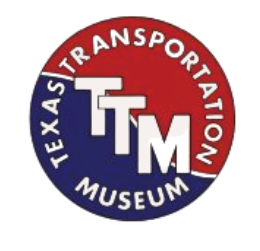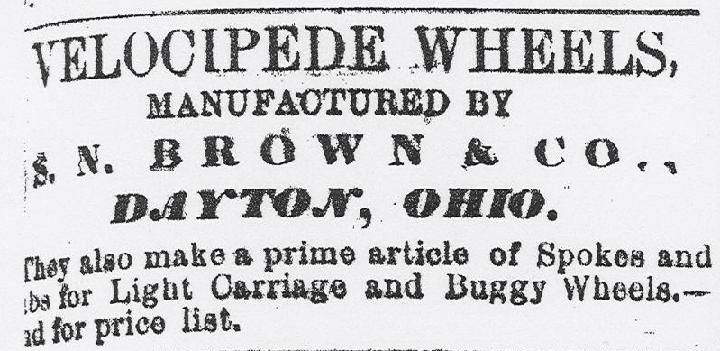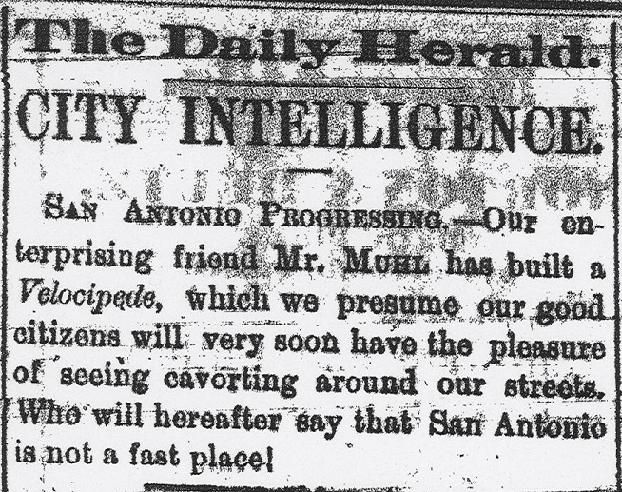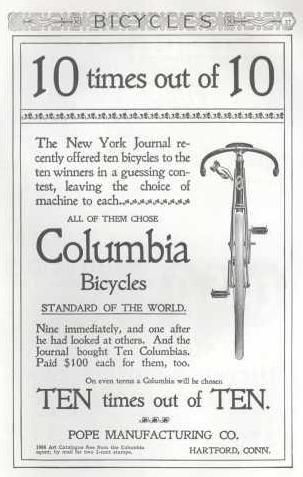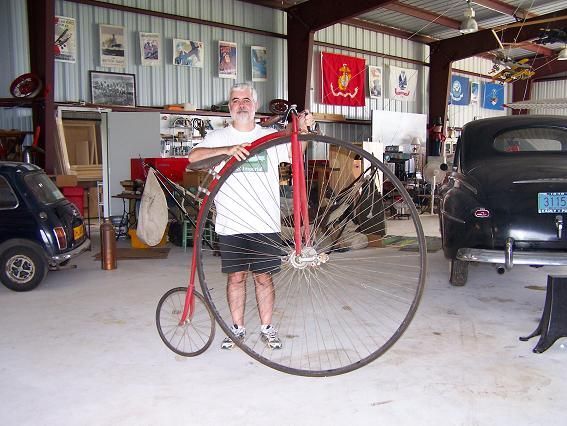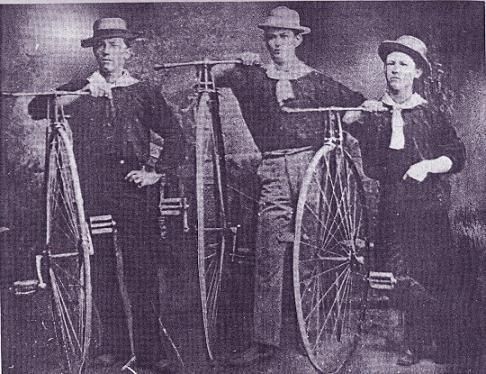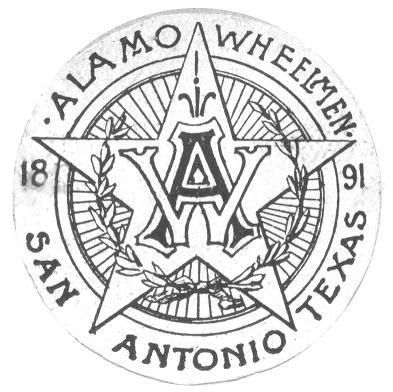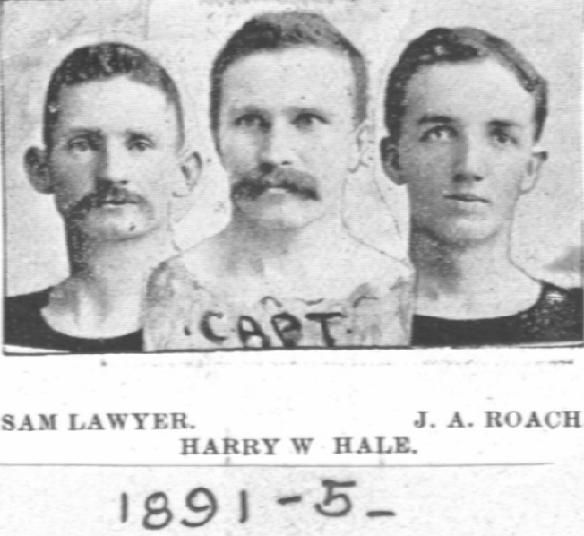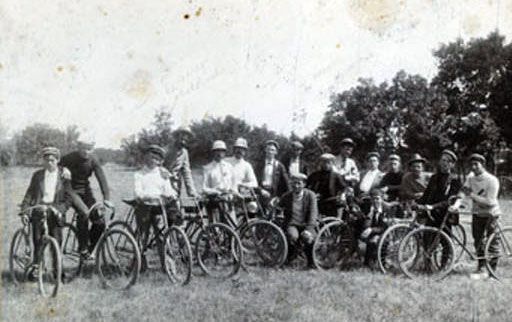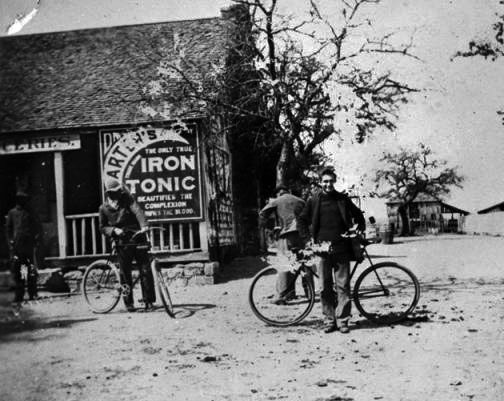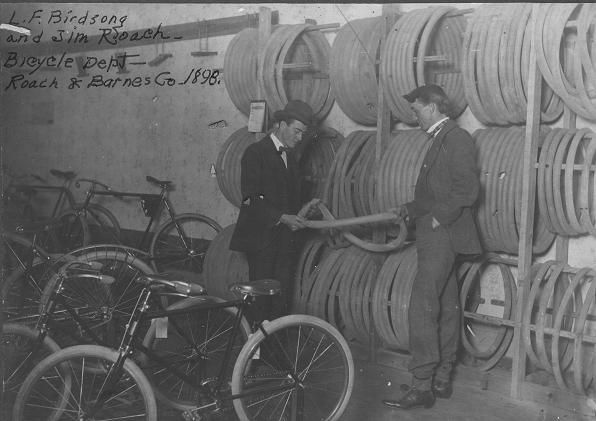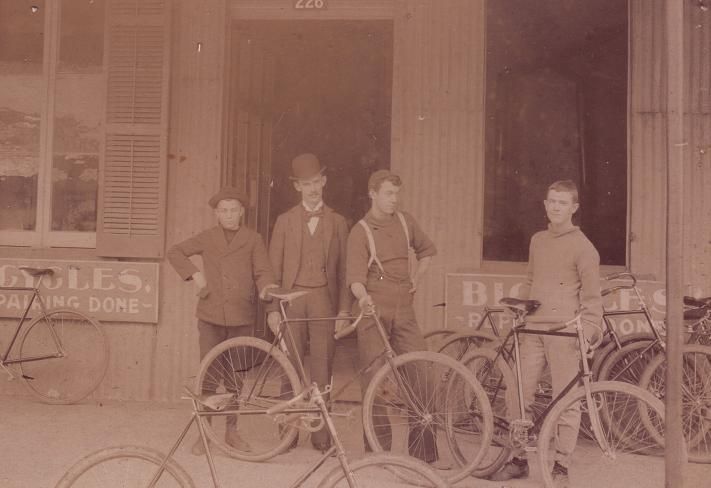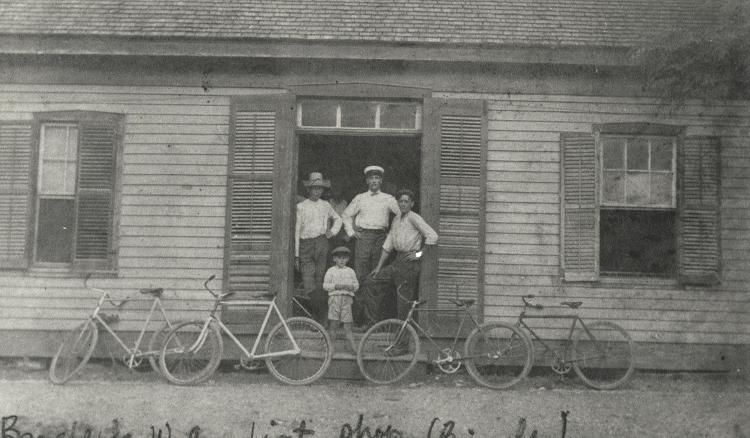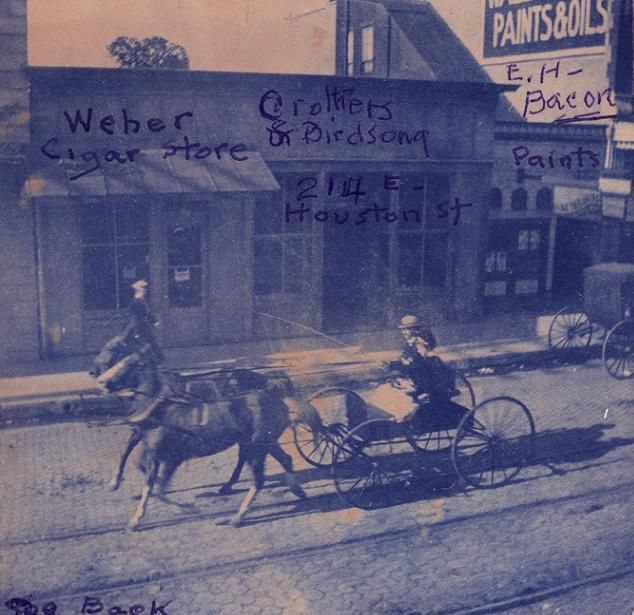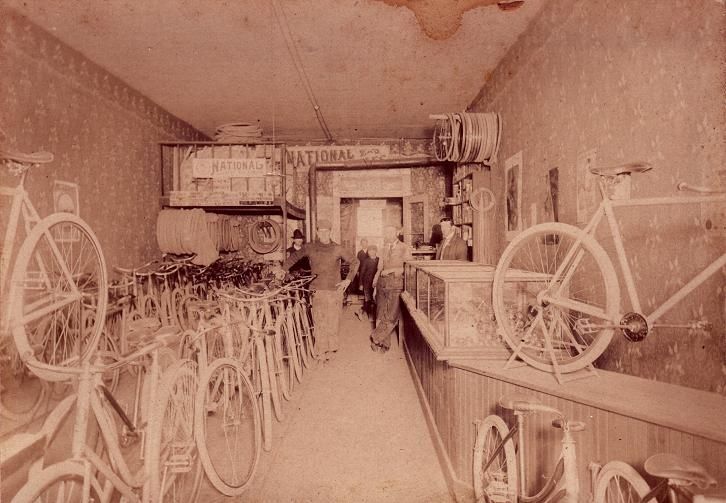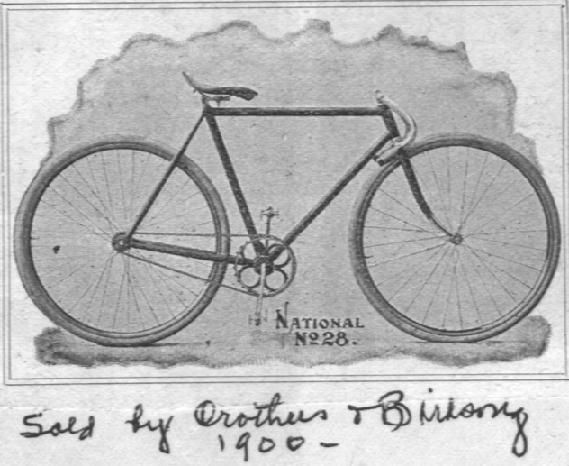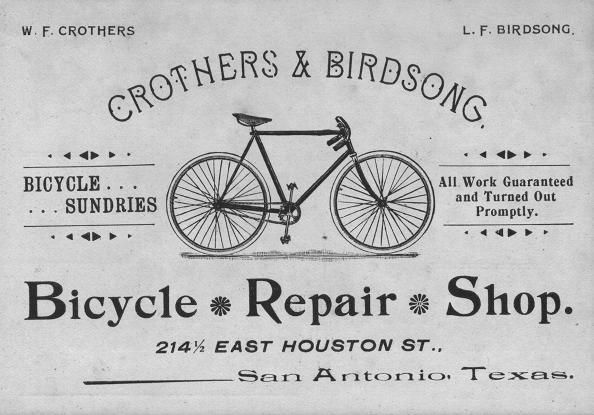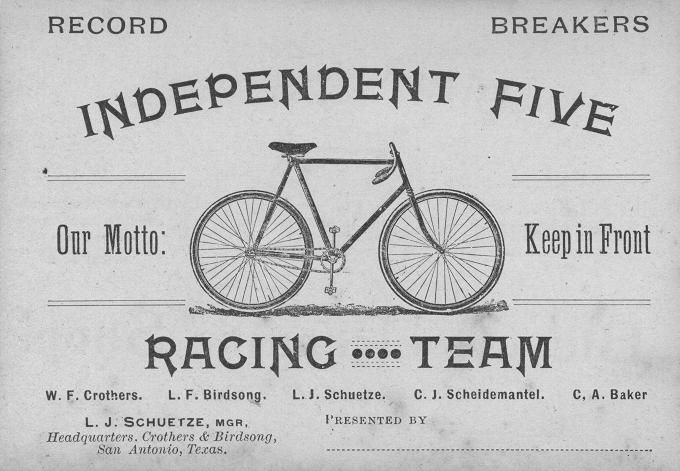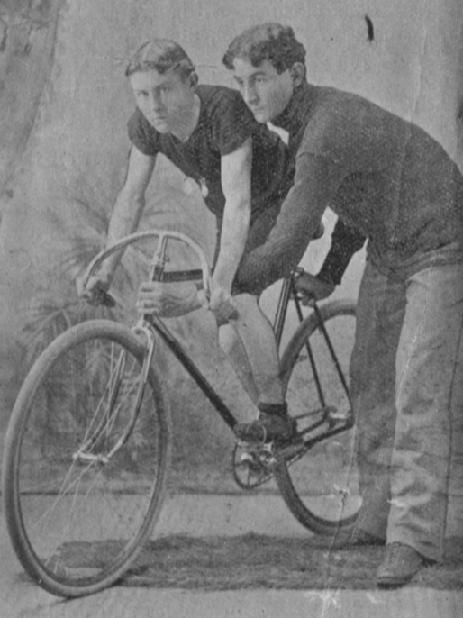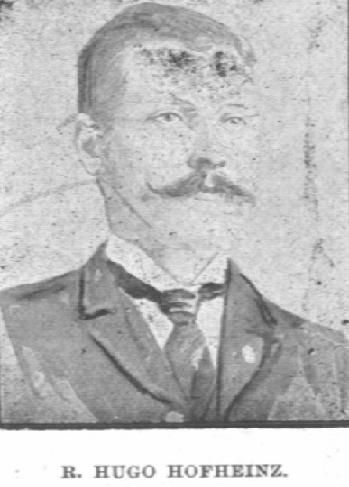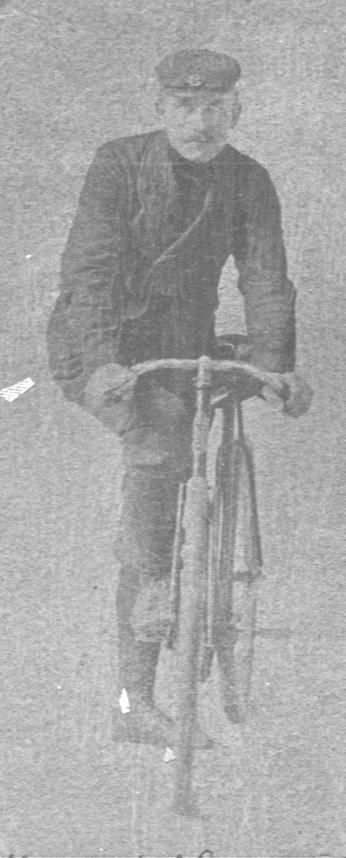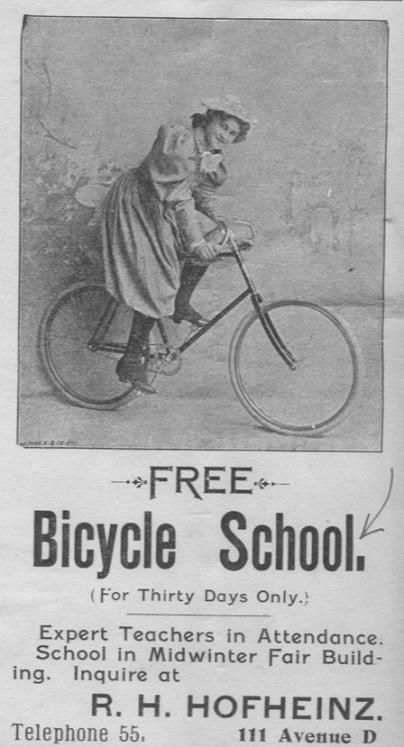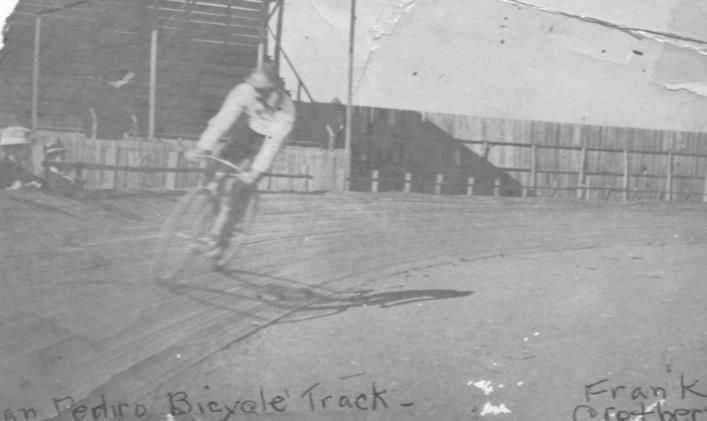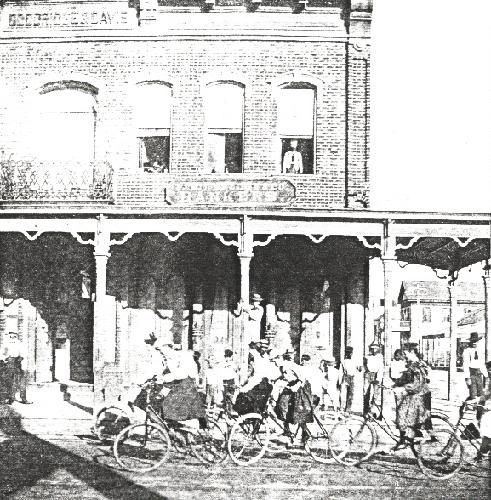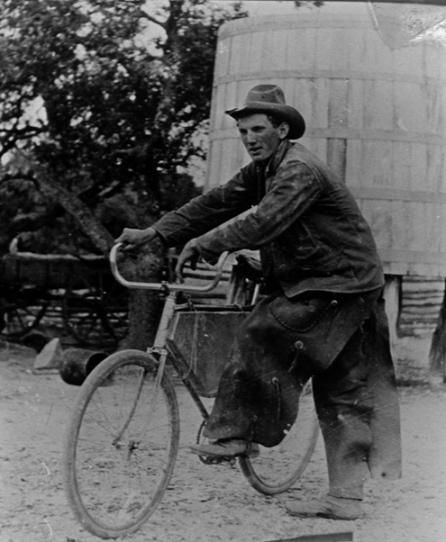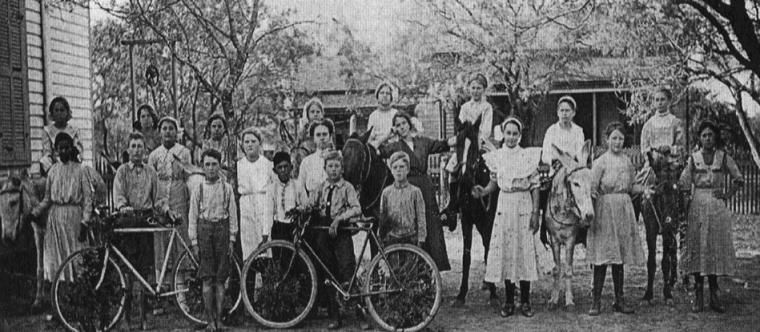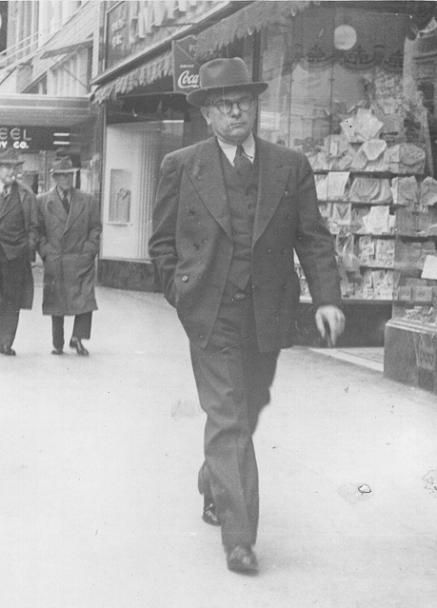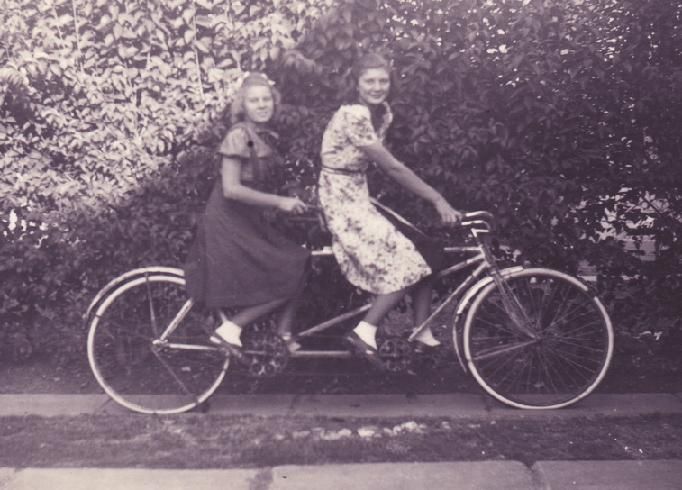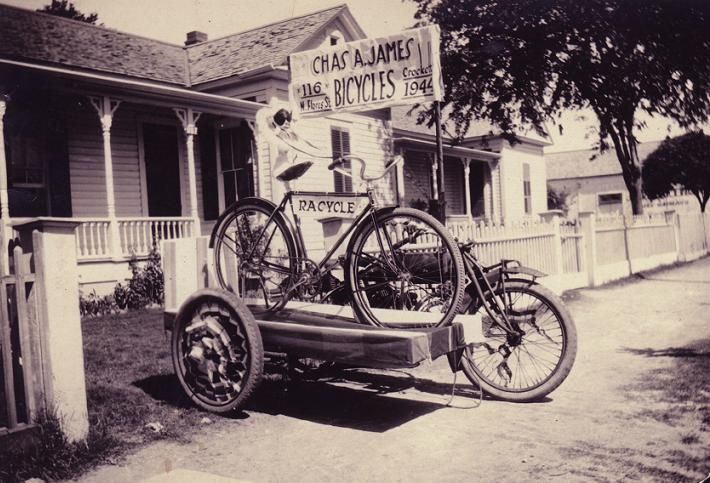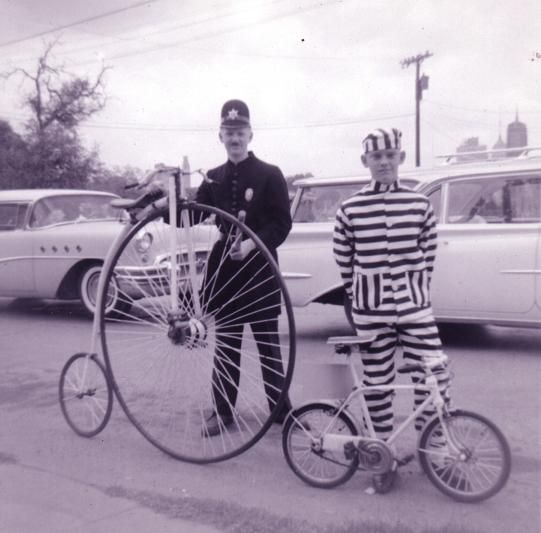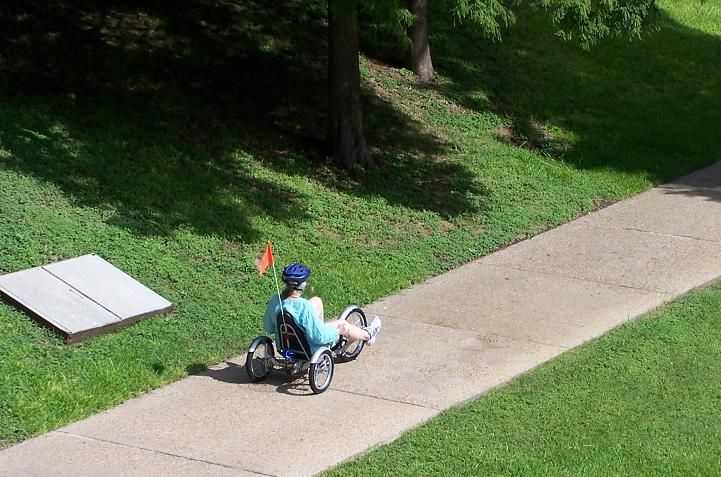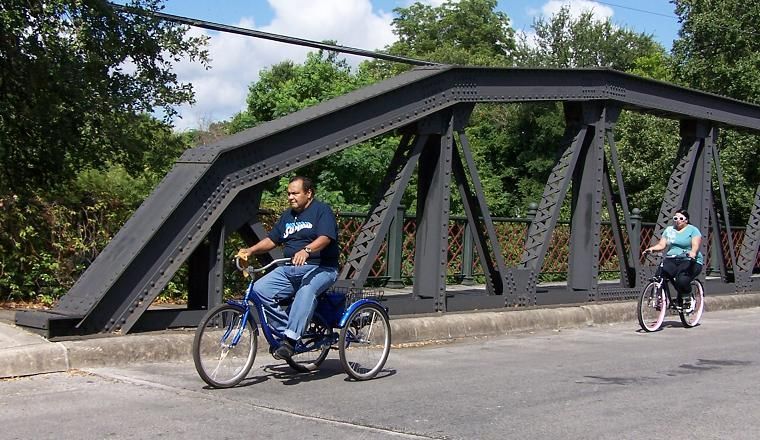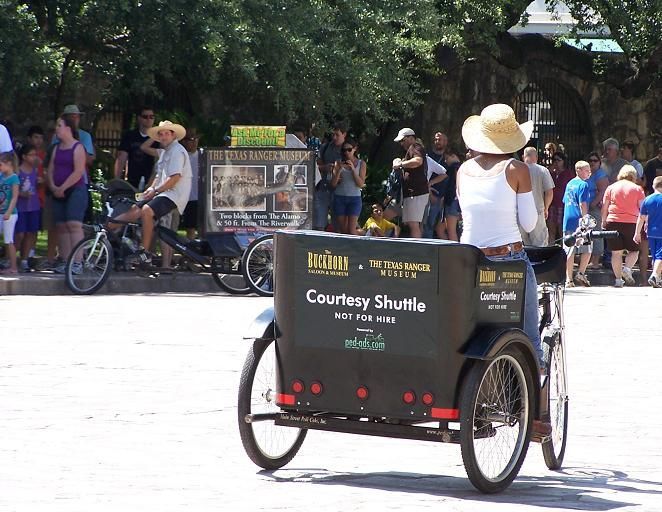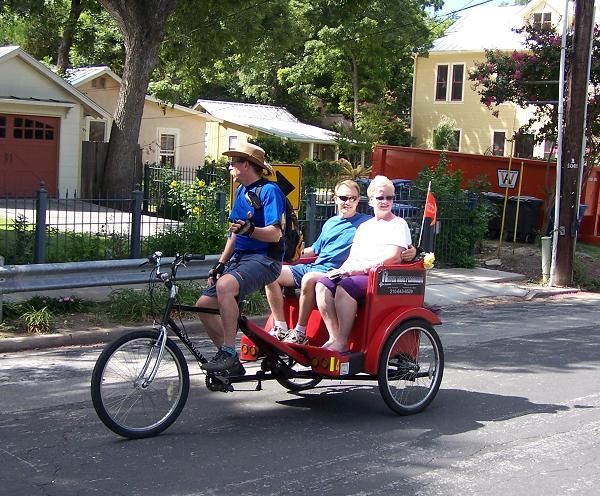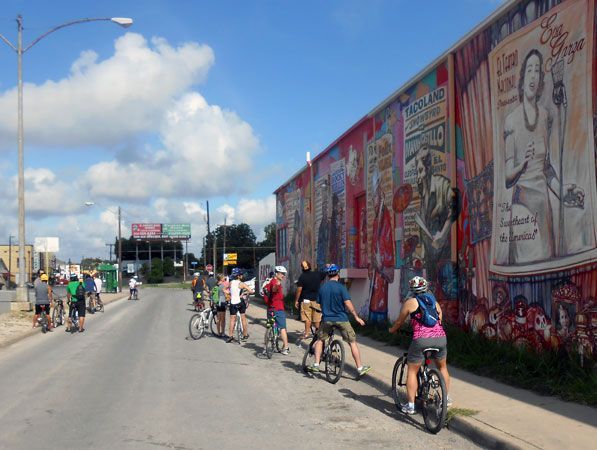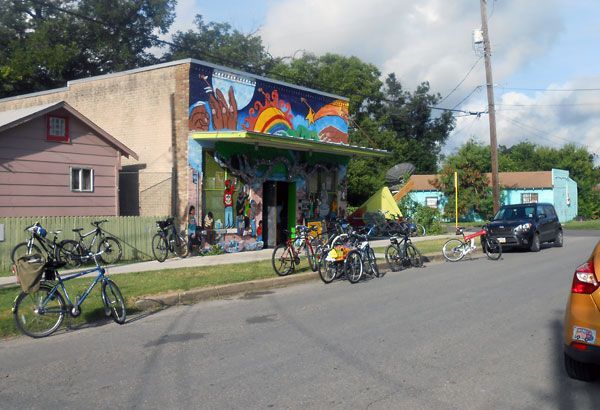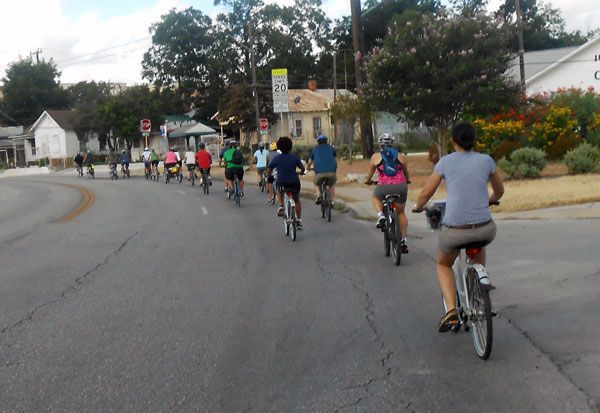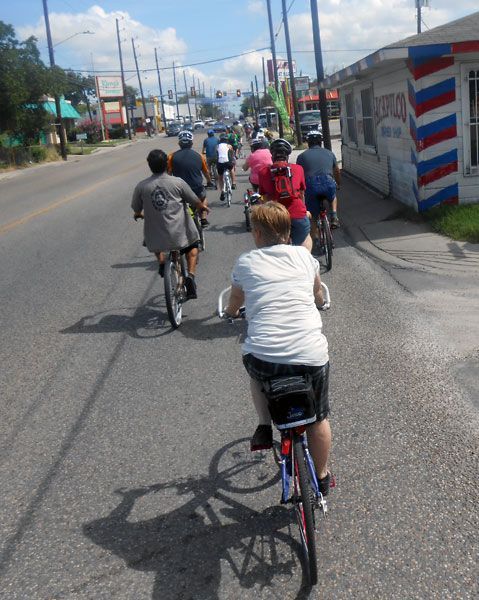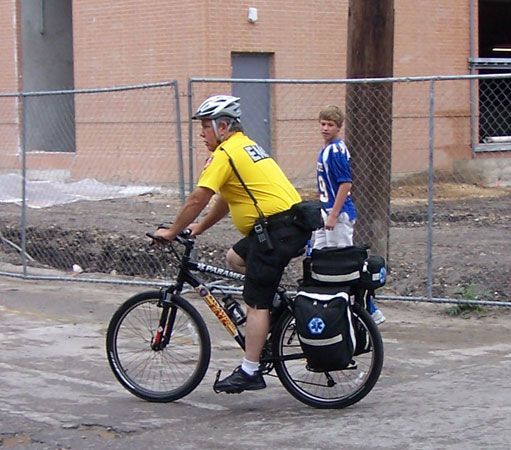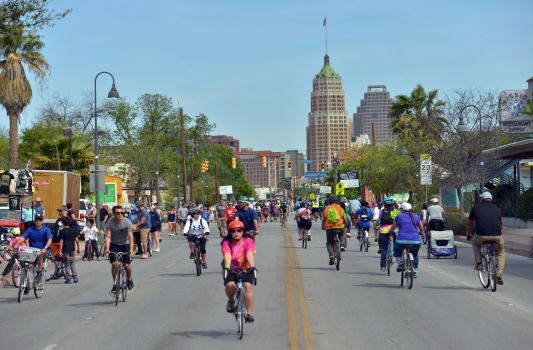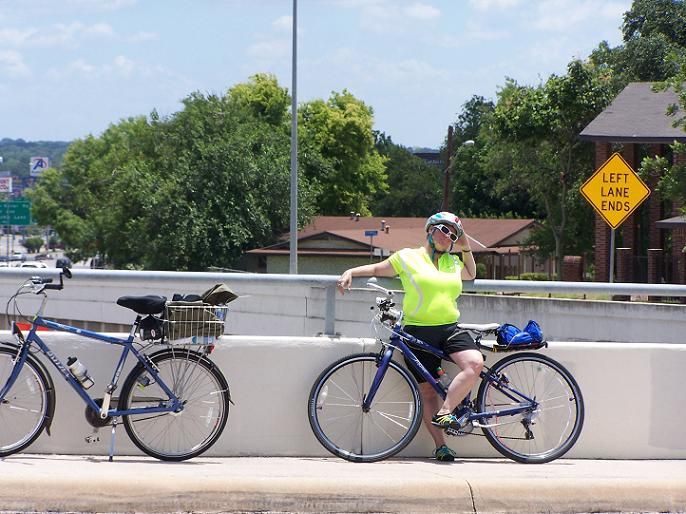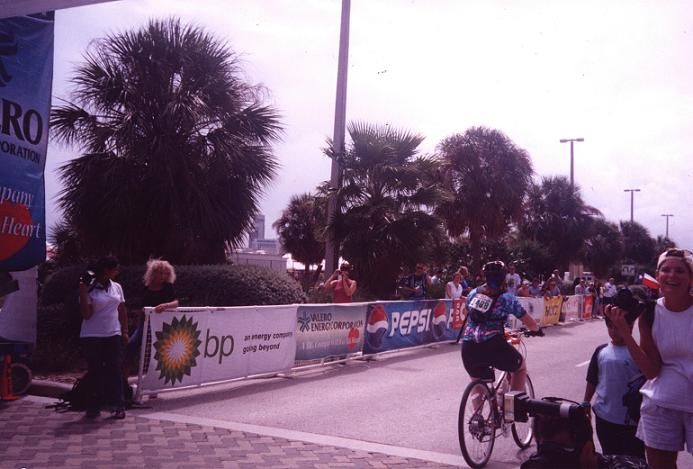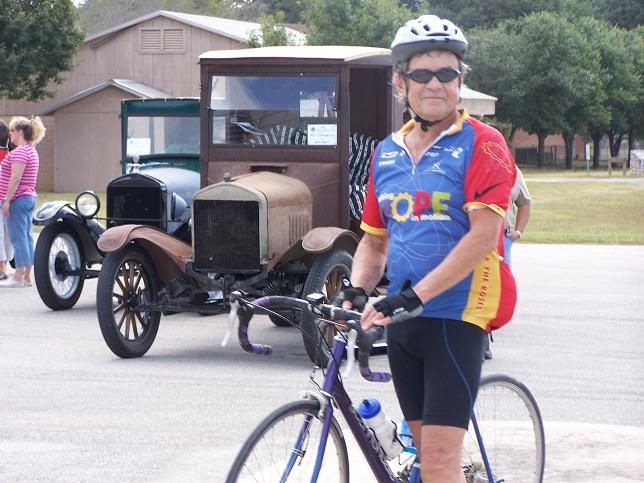San Antonio Bicycle History
There is an interesting anomaly in the history of San Antonio and South Central Texas transportation developments. Most archives have numerous images of people standing proudly with the spiffy machines but there is almost nothing in writing about the arrival of velocipedes and bicycles and the ensuing bicycle craze.
1869 bicycle related newspaper clippings, and a boneshaker
The first mention of a bicycle in San Antonio was on May 6, 1869, when the San Antonio Herald ran a piece about a local man, Mr. Muhl, who had built a velocipede, an early name for two wheeled machines. The first bicycle in Corpus Christi was recorded the same year. Muhl's machine was almost certainly a boneshaker, a type with wooden wheels, and metal "tires," with pedals directly attached to the front wheels. On the same page, there was an advert for velocipede wheels made by a company in Dayton, Ohio. Who knows how many people built their own bicycles? The author of the Muhl piece asked, "Who will hereafter say that San Antonio is not a fast place?"
Advert for Columbia bicycles, created by Alexander Pope, the father of the American bicycle.
The first modern "safety" bicycles, similar to those still in use today, was developed in England in 1879. Safety bicycles resolved most of the dangers and difficulties of earlier velocipedes. They were the culmination of over a hundred years of development by many different inventors. The safety bicycle achieved strength and speed from lightweight tubular frames and geared wheels of the same size. With pedals directly under the rider, they had a much lower center of gravity, which meant falling off was both less likely and had less severe consequences. They had effective brakes and the chain driven rear wheel could free wheel, allowing the rider to stop pedaling even if the rear wheel was turning, a significant improvement over direct drive boneshakers.
High wheelers in San Antonio.
The first American bicycle club, the League of American Wheelmen, was started during the high wheeler era in 1880. These machines had one very tall wheel and another much smaller one. The first bicycle store in San Antonio, owned by August Thiele and Jacob France, located at 302 West Commerce Street, sold high wheelers. These dangerous contraptions roamed the unpaved roads of San Antonio, ridden by dashing, devil may care young men like the Steves brothers, who would go on to make important contributions to San Antonio history.
The Alamo Wheelmen, formed in 1891, was San Antonio's first bicycle club.
The first bicycle club in San Antonio was formed in 1891. Called the Alamo Wheelmen, it was a chapter of the League of American Wheelmen. C.R. Clifford was president and George Walker vice-president. The club was the first in the area to promote the exciting new machines. They had their own racing team comprised between 1891 and 1895 of Sam Lawyer, Harry W. Hale and J.A. Roach. Mr. Roach was a part of the family that owned one of the biggest bicycle stores in town, Barnes & Roach.
Initially bicycles were expensive. In 1897, the Wagner & Chabot store, located at 129 W. Commerce, advertised a new top of the line Columbia model for $80.00 and a used one for $60.00. This is the equivalent of $2,063.00 and $1,547.00 in today's money. A new mid-range Sterling Model cost $65.00 and a used one $45.00. The lower range Hartford could be had for $50.00. The Sears catalog of the same year features six pages of bicycles and extras. Its top of the line model, the Yukon, sold for $56.50. The mid-range Utah cost $43.00 and the lowest priced bicycle, the Uno, available in male and female versions, cost $35.00.
San Antonio bicycle stores and one in Seguin.
In the late 1890s there were several bicycle specialist stores in San Antonio. As well as France & Thiele and Wagner & Chabot, there was H. Rhein at 601 Austin Street, A.H. Hofheinz at 111 Avenue D, W.E. Roach at 307 West Commerce Street and the Texas Cycle Works and located at 117 W. Houston. Bicycles were also sold by department stores, such as Joskes. In smaller towns, you could either get them at larger stores, such as Schreiners in Kerrville, local agricultural equipment supply stores and even the blacksmith. Demand in Seguin was strong enough to make a specialist store viable.
Crothers & Birdsong
Two young men, former employees at other bicycle stores, Frank Crothers and Louis F. Birdsong, who liked to be called L.F., opened their bicycle store in 1898. The store, at 214 ½ W. Houston, where the Majestic Theatre now stands, was very small. The business sharing their building sold cigars. They only sold one type of bicycle, the National. These were racing machines, noted for their light weight. They were costly and intended only for those seriously interested in competition. To bring in more revenue, they repaired typewriter and other appliances in addition to bicycles. Their central location was ideal for a Kodak agency. Selling cameras and providing film development and enlargement services had the additional benefit of giving them abundant access to photography an opportunity they used to the fullest in their travels.
Crothers & Birdsong
Both men were passionate about competition. They formed a team, "The Independent Five," consisting of themselves, L.J. Schuetze, C.J. Scheidemantel and C.A. Baker. Their National racing machines could be packed flat into a narrow canvas carrying case for easy transportation in railroad baggage cars. To keep weight to a minimum, less than thirteen pounds, all extraneous equipment was avoided. This included brakes and gears, including the free wheeling mechanism. They were designed to be ridden at the fastest rate possible around quarter mile tracks. At the end of the race the rider would begin applying back pressure, to slow the machine down. He could also lean forward and apply his leather gloved hands onto the front tire.
Crothers & Birdsong
The "Independent Five" whose motto was "Keep In Front," traveled to various destinations around Texas to compete. A national professional circuit was already well established. San Antonio, Laredo and Galveston were part of the national circuit in the 1890s. They were soon joined by Houston and Dallas as the population of these cities grew. Bicycle races in Texas attracted professionals from all over the country, such as Iowa, Michigan, California, Illinois, Colorado, Kansas, Alabama, New York and, of course, Texas itself. Smaller towns, such as Victoria, Tyler and Waco, held amateur races in conjunction with other events such as county fairs. Bicycle racing became the number one spectator sport in America.
Bastrop professional cyclist, Bruno Elzner
Many Texas cities had a professional rider. Cuero had George Anderson, Corpus Christi J.F. McCann, Bastrop Bruno Elzner and Waco, L.W. Johnson. The pride of San Antonio was A.H. Hofheinz, known as Hugo. As well as being a professional racer, his bicycle store on Avenue D offered free bicycle lessons where people could learn to ride. He also organized road races in San Antonio. In 1896 both Crothers and Birdsong took part in his race over the "Mission Course." Five hundred people gathered at the starting and finish point at the intersection of Roosevelt and Perieda, with many more lining the unpaved streets to witness the excitement. Of the thirteen participants, Crothers came in third and Birdsong ninth. Both the Barnes & Roach and Crothers & Birdsong bicycle stores provided some of the prizes.
San Antonio professional cyclist, Hugo Hofheinz
Bicycle racing facilities differed greatly from city to city. In smaller towns races were run on the same dirt courses used for horse racing. This caused a problem in Victoria in 1899 when the course was neither dragged nor rolled, creating very difficult conditions for machines with narrow tires and no brakes. Nonetheless Jim Roach of San Antonio managed to achieve a time of only thirty-three seconds to complete the quarter mile dash to win second place in the amateur competition. Likewise, L.F. Birdsong took first place in the half mile sprint, coming from the rear to win, with front wheel off the ground, in only one minute nineteen seconds. Jim Roach also took first place in the one mile amateur race, at three minutes twenty-one seconds, with Birdsong taking second. It was obviously San Antonio's day. Hugo Hofheinz won the two mile professional race, on the same unprepared dirt track, in only 6 minutes, 25 seconds.
Frank Crothers at the San Antonio bicycle race track.
San Antonio did not have a venue dedicated solely to bicycle racing. Instead a high banked oval made of wooden boards was installed around the dirt horse racing track belonging to the San Antonio Jockey Club, located just off of Broadway, near the present site of Lion's Field. This proved to be a satisfactory arrangement and many races were held there in front of huge crowds. In the late 1890s Houston and Dallas built "velodromes" dedicated to nothing but bicycle racing. These could seat upwards of two thousand people around high banked quarter mile ovals.. The "Independent Five" made several pilgrimages to these modern racing venues and acquitted themselves well.
Female cyclist portrait, Center Point, Kerr County.
Outside of the dedicated few willing to travel around the state for the chance to compete for small prizes, the seemingly innocuous bicycle brought about a significant amount of societal change. It had a particularly liberating effect for women. It was said by no less a person than Susan B. Anthony that the bicycle was the greatest invention of the 19th century for the emancipation of women. Cycling in corsets, stays and bustle back dresses was impossible, leading to changes in dress that were regarded as offensive by many. Bicycles with lower crossbars were introduced to accommodate petticoats and skirts but, before you knew it, some brash young souls dared to go out in, of all things, pants! Oh, the shame of it all! There were professional women racers. One of the most famous was Bertha Wagner, who was also a journalist and writer. Descriptions of her abilities included words such as strong, brave and intelligent. She attained enough fame to gain the respect of male racing aficionados, and was usually the favorite to win during her racing career.
Professional female cyclist, Bertha Wagner.
To maintain propriety, the San Antonio Express ran a lengthy article in 1895 detailing the correct etiquette of bicycle riding for both men and women. A gentleman would not, and others should not, stand astride his machine during a conversation. He should also be prepared to extend any and all courtesies to members of the fairer sex including dismounting first to steady the lady's bicycle, plus hold it once more as she got on. He was expected to make any and all repairs, lest the lady's white gloves become besmirched. Most of the rules were directed at women, however. Riding alone was absolutely beyond the pale. A gentlemen escort was always preferred, such as a husband or brother, but a maid would do in a pinch. Bicycling was only ever to be done in the morning. No decent lady would ever be seen on a bicycle after midday, unless attending a bicycle tea or other related social event.
Bicycles on Alamo Plaza, 1910
Cyclists were among the most ardent early campaigners for better roads. Such efforts led to a number of improvements. Within San Antonio side walks were created. Mesquite blocks were laid in the heart of the city, including Houston Street where Crothers and Birdsong had their store. Other main roads were macadamized, which involved laying down courses of stones of diminishing size towards the surface. These streets needed to be watered down every day to keep down the dust, and regularly dragged to avoid ruts made by heavily loaded wagons.
Girls on bikes in Corpus Christi around 1900.
Cyclists were among the most ardent early campaigners for better roads. Such efforts led to a number of improvements. Within San Antonio side walks were created. Mesquite blocks were laid in the heart of the city, including Houston Street where Crothers and Birdsong had their store. Other main roads were macadamized, which involved laying down courses of stones of diminishing size towards the surface. These streets needed to be watered down every day to keep down the dust, and regularly dragged to avoid ruts made by heavily loaded wagons.
Cyclist in Kerrville, Texas
Bicycles were also popular in smaller towns. Noted New Braunfels historian Oscar Haas, born in 1885, rode along the byways as a teenager, making sketches and taking snap shots of animals, people, houses and the landscape. Such expeditions on primitive trails, dealing with land owners and their various animals, crossing small streams and the often swollen Guadalupe and Comal rivers, must have been a wonderful adventure. Haas almost certainly visited Crane's Mill, six miles west of New Braunfels, where he was born and lived until he was twelve. This area is now under Canyon Lake.
Marion, Texas school children.
The arrival of the automobiles ended the bicycle craze. One by one the "velodromes" closed across Texas. The last bicycle races at the San Antonio Jockey Club track were held in 1910. Prices plummeted and many manufacturers quit the business. The space devoted to bicycles in the 1900 Sears catalog dropped to only three pages, half their 1897 level. A top of the line Acme King, available for both men and women, cost only $15.75, a far cry from the $56.50 needed to acquire the 1897 premium model. The mid-range Acme Prince could be had for $14.75 and the Acme Jewel for $13.75. Paradoxically the number of stores involved in their sales increased in San Antonio. In 1907 there were nine bicycle stores in San Antonio. The early era peak was reached in 1911, when ten bicycle businesses were listed in the city directory, along with five bicycle messenger services, A.D.T., B.B.B., Prompt Call Messenger, Q.C. Messenger Service and S.A. Messenger Service.
San Antonio bicycles as a war time economy in 1942
The post war baby boom and the growth of the suburbs created an environment ideal for youthful bicycle activities. Having survived the hard times, Charles James was able to reap the rewards of the prosperity. His teenage grandson, Chuck Anderson, recalls that in the late 1950s the store would rent a warehouse in the fall to store the many bicycles purchased as Christmas presents. It was Chuck's job to be a "Secret Santa," and somehow deliver the bikes around the city without being detected by the children and ruining their surprise. At this time the cost of a quality machine, with three speed gears built into the rear wheel hub, ran around $40.00.
Chuck Anderson in the Battle of Flowers parade in the 1950s.
Running the James store had always been a family affair. Chuck's mother, Florence, and his aunt, Margie, rode the store's tandem bicycle in parades to publicize the business. Chuck and his school friend, Lennie Fein, went one better. They would dress up like the Keystone Cops when participating in the Battle of Flowers in the 1950s. Chuck would be on one of the store's two fully sized high wheelers and Lennie on a child's bike. They had permission from the parade officials to roam freely along the route and provide some comic relief to the stately progression of the larger floats. The store is still in business more than eighty years after it was started though it is now under new ownership.
There was a national resurgence in bicycling in the early 1970s. In 1971 Neil Collins placed a note on the notice board at Charles James asking if anyone wanted to go biking together. New San Antonio resident Don Schwarz, having gravitated to what was then the only bike store in town, responded along with about fifteen other people. Within a short time, the long dormant name, Alamo Wheelmen, resurfaced, but not for long as the new club decided to use the less historic "San Antonio Wheelmen" name.
Soon new specialist bike stores began to pop up, such as Bike World in 1971 and B & J Bicycles in 1972. Within a year the San Antonio Wheelmen had attracted some seventy members. As the popularity of the sport increased the club began campaigning for dedicated bike lanes. They also successfully lobbied for bike racks to be installed on VIA buses to allow people to move their machines across the city with greater ease. Even the police got into the act, inaugurating downtown bike patrols in 1990.
Today the world of bicycling has become quite complex. Added to the old division between pacers and racers, which is to say those who love to race and those who simply want to go out on leisurely tours, are the new breeds of off-road and mountain bikes, plus youth oriented machines designed for performing tricks and stunts in specially created parks, featuring larger versions of what skate boarders call half pipes, which allow riders to perform gravity defying tricks in the air on each side of a steeply curved rise.
Finishing line at the MS150 in Corpus Christi.
Using the bicycle for charity events has become very popular. One of the biggest events is the MS150. 2009, the 20th year for the event, will have a different route than in the past. Instead of going to Corpus Christi, the cyclists will go to New Braunfels on a country route that will take them through several communities, including Lavernia. The MS150 attracts around 3,000 riders and raises over $1.5 million annually towards finding a cure for Multiple Sclerosis. It is not a race and is open to every kind of participant, from novices to seasoned professionals. Some, like Erika Stoltz, have the disease and participate in the event not only to raise money for the cause but also to tell the world they are still the masters of their own fate.
Another big event harks back to Hugo Hofheinz's Mission Races of the late 1890s. The Mission Trail Rotary Club organizes a series of bicycle courses, ranging from 58 miles for the most experienced riders to 12 miles for beginners and families, around San Antonio's historic missions. 2009 will be the twelfth year for the event, which raises money for a number of local charities, including Meals on Wheels and the Senior Companion program.
Modern cyclist and Ford Model Ts near Uvalde.
Bicycles continue to attract people over one hundred and twenty years after the safety type was introduced. Learning to ride a bike is a rite of passage for youngsters everywhere. Parents, seeing their child's first independent movement away from them, are reminded of the simple joys to be had from this healthy activity. It is worth mentioning that there is almost nothing on earth as efficient as a human being on a bicycle. Using less "fuel" than is needed for walking, an average person on a bike can achieve speeds much faster than running, for far longer periods of time.
San Antonio Bicycle Timeline
━━━━━━━━━━━━━━━━━
1869
The San Antonio Express announces the city's first bicycle, a home made "bone-shaker." On the same page of the paper is an advert for bicycle wheels.
━━━━━━━━━━━━━━━━━
1879
The modern safety bicycle, safer because of a low center of gravity thanks to two equal sized wheels with pedals under the rider driving the rear wheels with a free-wheeling chain, and lever operated brakes on both wheels, is developed in England
━━━━━━━━━━━━━━━━━
1880
The first bicycle club in the USA - The League of American Wheelmen - is formed
━━━━━━━━━━━━━━━━━
1885
Noted historian Oscar Haas rides his bicycle as a 12 year old in and around New Braunfels, taking notes and making drawings
━━━━━━━━━━━━━━━━━
1891
San Antonio's first bicycle club - The Alamo Wheelmen - is formed
━━━━━━━━━━━━━━━━━
1895
The San Antonio Express runs a lengthy article giving strict etiquette guidelines for the proper use of bicycles by ladies
━━━━━━━━━━━━━━━━━
1896
500 people gather at the corner of Roosevelt Avenue and Perieda to watch the beginning and end of the "Mission Course" bicycle race over streets yet to be paved
━━━━━━━━━━━━━━━━━
1897
Bicycles remain very expensive. Wagner & Chabot's at 129 W. Commerce sell the top of the line Columbia machine for $$80.00 - the equivalent of $2,100.00 today. Their lowest priced range costs $35.00
Many local towns had produced a professional racer. In San Antonio it was Hugo Hofheinz who also operated a store on Avenue D where he provided bicycle lessons.
━━━━━━━━━━━━━━━━━
1898
Instead of a purpose built "velodrome" a banked oval is installed at the San Antonio Jockey Club horse race track Near Broadway
Two young men open the Crothers & Birdsong bicycle store at 214 E. Houston to sell and service National racing bicycles exclusively. To make ends meet they are a Kodak agency and also service typewriters. They will later sell San Antonio first automobile, a Curved Dash Oldsmobile, in 1902
━━━━━━━━━━━━━━━━━
1899
There are now seven bicycle stores in San Antonio. They are also sold at department stores like Joskes in San Antonio and hardware stores in smaller towns, plus can be ordered through the Sears & Roebuck catalog
━━━━━━━━━━━━━━━━━
1900
Various city by-laws govern the use of bicycles in San Antonio. An 8 MPH speed limit exists within the city limits. Bicycles must be fitted with a bell that must be rung three times during the approach to all intersections
━━━━━━━━━━━━━━━━━
1907
There are 9 dedicated bicycle stores in San Antonio
━━━━━━━━━━━━━━━━━
1911
The bicycle craze is well and truly over. The last bicycle race, so recently the biggest sporting event in the nation, is held at the San Antonio Jockey Club. Sears has reduced the number of pages in its catalog devoted to bicycles to three. The price of a top of the line bicycle is $15.75
There are 11 dedicated bicycle stores in San Antonio
━━━━━━━━━━━━━━━━━
1924
The Charles James store opens at Main and Houston, joining four other dedicated bicycle stores
━━━━━━━━━━━━━━━━━
1933
Only the Charles James store remains as a dedicated bicycle store in San Antonio
━━━━━━━━━━━━━━━━━
1971
The national resurgence of interest in bicycling as both a sport and a leisure activity comes to San Antonio when a new resident posts a note on the notice board in the Charles James store. From this seed the "Alamo Wheelmen" club is reborn but son changes its name to the San Antonio Wheelmen.
Bike World opens its first store in San Antonio
━━━━━━━━━━━━━━━━━
1972
The B & J bicycle store opens
━━━━━━━━━━━━━━━━━
1989
The first MS150 bicycle race between San Antonio and Corpus Christi to raise funds for Multiple Sclerosis research takes place
━━━━━━━━━━━━━━━━━
1990
The San Antonio police department begins its first downtown bicycle patrols
━━━━━━━━━━━━━━━━━
1997
The Mission Trail Rotary Club organizes a series of rides of different lengths for different skill levels, from 12 to 58 miles centered around San Antonio's historic missions
━━━━━━━━━━━━━━━━━
2011
The "B Cycle" San Antonio bike sharing program is inaugurated. There are six clubs listed on the official city web site dedicated to cycling issues. There are over twenty bicycle stores. There are numerous hike and bike trails across the city. Official bike route signs are posted across the city. Official bike lanes allowing riders to occupy the entire lane are posted in the downtown area.
Frank Crothers at the San Antonio bicycle race track.
Transportation Museum
CONTACT US TODAY
Phone:
210-490-3554 (Only on Weekends)
Email:
info@txtm.org
Physical Address
11731 Wetmore Rd.
San Antonio TX 78247
Please Contact Us for Our Mailing Address
All Rights Reserved | Texas Transportation Museum
